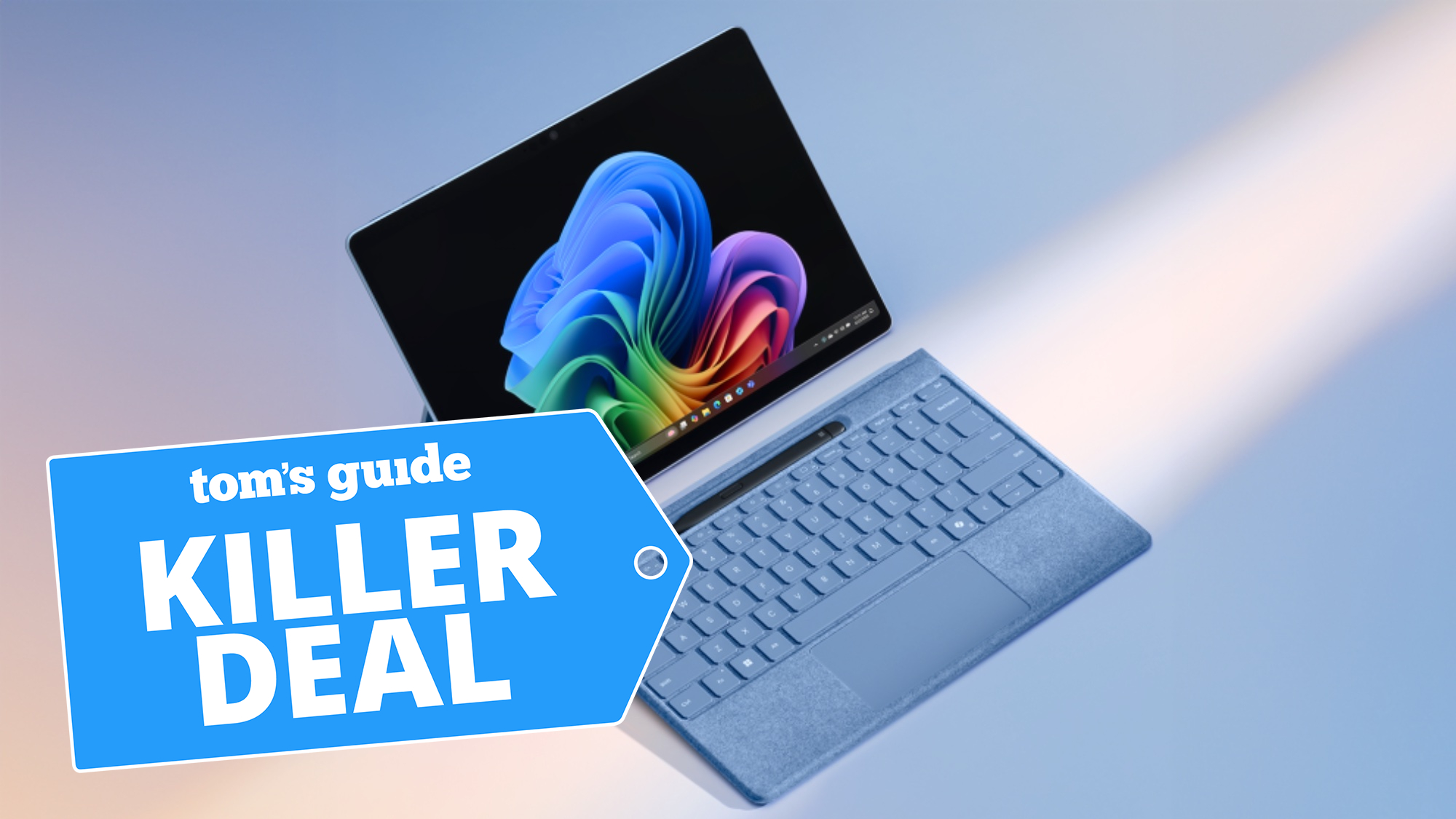ASRock AMD Radeon RX 9060 XT Challenger 16GB OC review: Cool & efficient!
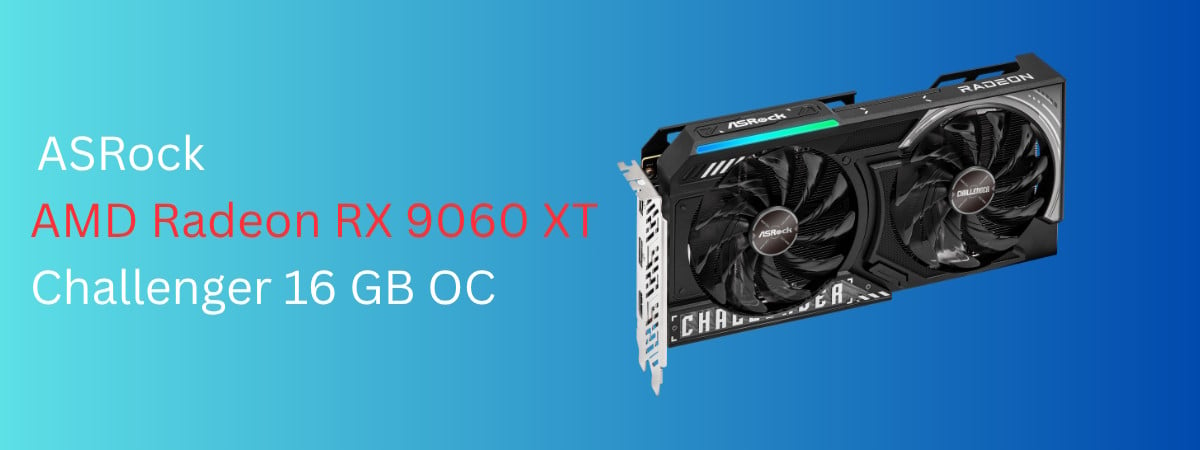
ASRock’s Challenger series of graphics cards is known for delivering good performance without unnecessary extras that unavoidably raise prices. The new ASRock AMD Radeon RX 9060 XT Challenger 16GB OC respects this philosophy and is designed to balance performance, efficiency, and affordability. Therefore, it combines AMD’s latest RDNA 4 architecture with 16GB of VRAM (which is excellent for modern games) and a robust cooling system, all at a “restrained” price. I spent a week testing this GPU, and I’d like to share with you details about its performance in real life, gaming scenarios, and benchmarks. If you, too, are curious to know more about this graphics card, read on and see if it’s worth upgrading to it or not:
ASRock AMD Radeon RX 9060 XT Challenger 16GB OC: Who is it good for?
This graphics card can be a good choice for:
- PC gamers who avoid overspending yet want good performance when playing in 1080p and 1440p
- Users building a compact or mid-sized PC who need a shorter GPU with efficient cooling
- Those who are upgrading from older entry-level GPUs like the AMD Radeon RX 7600
Pros and cons
This is what I like about this graphics card:
- Excellent gaming performance at 1080p resolution, and good enough at 1440p
- 16 GB VRAM, ideal for modern games that demand increased memory
- Noticeable ray tracing performance improvement over previous generations
- Efficient cooling system with minimal noise
- Reasonable size, suitable for most PC cases (it has a short 249 mm length)
- Requires only one 8-pin power connector
Here’s what I don’t like as much:
- Ray tracing still lags behind similar offers from NVIDIA

Verdict
After testing the ASRock AMD Radeon RX 9060 XT Challenger 16GB OC, I think it’s a good choice for budget-conscious gamers who are interested in smooth gameplay at 1080p or 1440p resolutions. The performance gains over the previous generation are significant, and the addition of AMD FSR 4 helps improve the gaming experience. Although NVIDIA’s alternatives are still ahead in terms of raw ray tracing performance, the Radeon RX 9060 XT manages respectable frame rates even with ray tracing enabled. Taking into account its efficient power consumption and quiet cooling, ASRock’s Radeon RX 9060 XT Challenger 16GB OC is an excellent upgrade from the likes of older AMD cards like the Radeon RX 7600 or previous-gen NVIDIA models such as the GeForce RTX 4060. This is especially true if you can get it close to the recommended price of $349.
Unboxing the ASRock AMD Radeon RX 9060 XT Challenger
Unboxing the ASRock AMD Radeon RX 9060 XT Challenger 16GB OC is a straightforward experience. The card arrives in a good-looking box that features the Challenger logo and a photo of the card on the front. It also showcases some of its main features, like the 16 GB of video memory and the fact that it’s factory-overclocked.


The packaging is shiny and features a photo of the GPU
The graphics card is packed in protective foam, inside an anti-static bag. When you unbox everything, you notice that ASRock includes just the essentials: besides the GPU, I only found a brief quick-start guide, warranty information, and other leaflets.
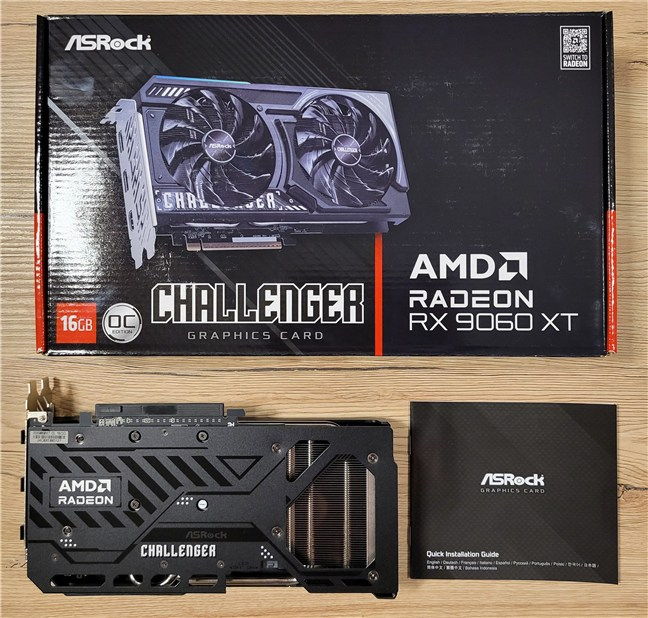

Unboxing the card is straightforward: no extras
Don’t expect extras like cables, stickers, or whatnot. ASRock provides only straightforward packaging. Still, it looks good and ensures the GPU arrives safely.
Design and hardware specifications
The ASRock AMD Radeon RX 9060 XT Challenger is built upon AMD’s RDNA 4 architecture, which is designed to deliver improved performance and power efficiency. This particular model comes with 32 Compute Units and 2048 Stream Processors, clocking up to a maximum of 3290 MHz, which is quite impressive. It’s also equipped with 32 Ray Accelerators and 64 AI Accelerators, giving it enough horsepower for today’s advanced rendering and upscaling techniques. Backing that up are 16 GB of GDDR6 video memory running on a 128-bit interface, with a fast 20 Gbps speed and total bandwidth reaching 320 GB/s. This provides enough memory and bandwidth for modern games at 1080p and 1440p, even with high-resolution textures.
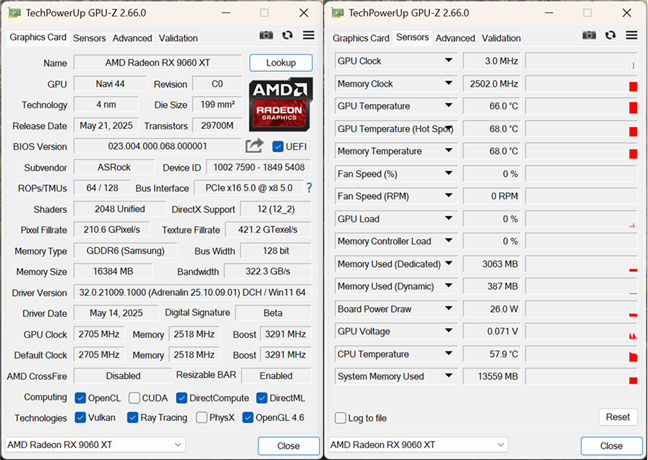

The specifications of the ASRock Radeon RX 9060 XT Challenger
Numbers are only part of the story, though: it’s worth mentioning that ASRock did a pretty good job with the cooling solution. The Challenger features striped axial fans for better airflow, ultra-fit heat pipes that maximize contact with the heatsink, and a high-density metal welding setup that improves thermal transfer. Oh, and when your system isn’t under stress, the fans slow down to a complete stop, so you won’t hear a thing from the graphics card.
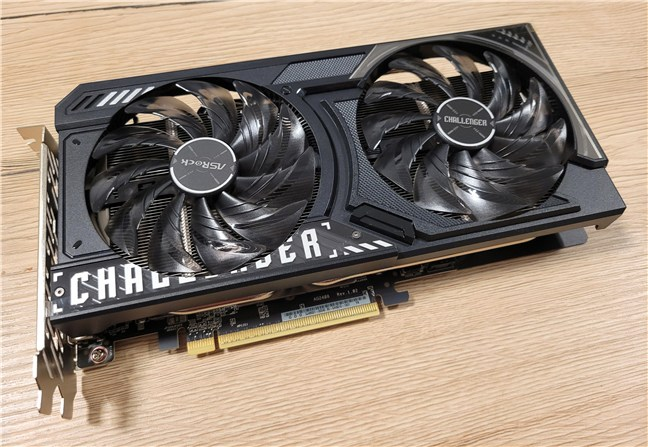

The cooling system appears to be well designed
The power delivery system is built with Dr.MOS integrated components and a premium 2oz copper PCB, which helps the card stay stable even during demanding workloads. The build is solid, with a matte black PCB, a full metal backplate, and an LED on/off switch if you want to disable the integrated RGB LED stripe. Mind you, this is a subtle lighting touch, with just a clean, narrow glow on the side of the GPU.
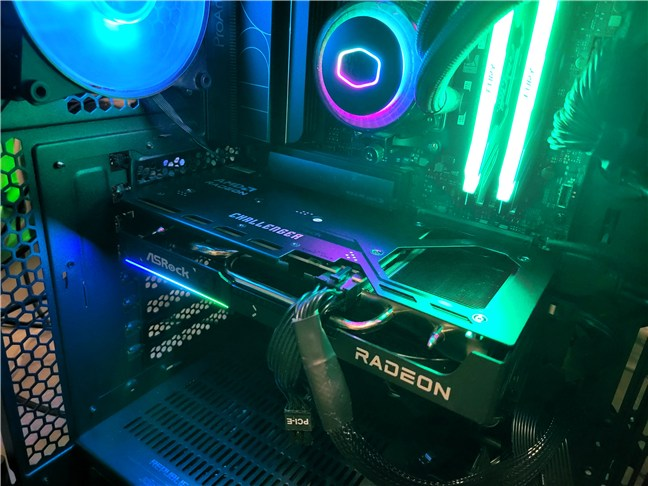

There’s also a discreet LED strip on the GPU
The card itself measures 249 x 132 x 41 mm (or 9.8 x 5.2 x 1.6 inches) and weighs 645 grams (or 1.42 pounds). It should fit easily in most mid-tower and compact cases. It only needs a single 8-pin power connector, which is more than enough considering the Radeon RX 9060 XT’s modest power requirements. With a maximum total board power consumption of just 180W, ASRock recommends pairing this Challenger model with a 550W power supply.
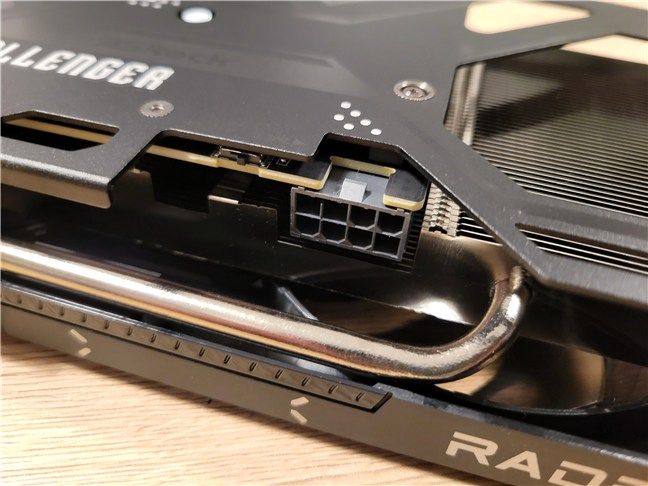

You only need one power cable
On the connectivity front, you get two DisplayPort 2.1a outputs and one HDMI 2.1b, which supports modern high-refresh monitors and even 8K displays.
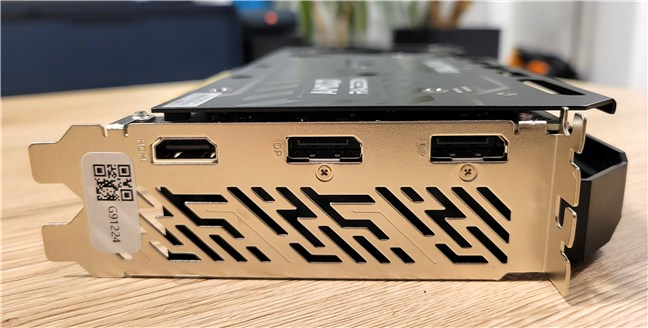

The card has two DisplayPort and one HDMI outputs
The Radeon RX 9060 XT comes with support for the latest graphics technologies, including DirectX 12 Ultimate, Vulkan, hardware-accelerated ray tracing, and AMD’s FidelityFX Super Resolution 4. As part of the RDNA 4 family, it can take advantage of AI-based upscaling and frame generation through FSR 4. This lets the card render at a lower resolution and then upscale the image, helping increase frame rates. More and more games are adding support for FSR 4, so this feature is something you may be interested in. 🙂


As an RDNA 4 model, the card supports AMD FSR 4
Image source: AMD
For more technical details, visit the official ASRock Radeon RX 9060 XT Challenger 16GB OC webpage.
The ASRock Radeon RX 9060 XT Challenger 16GB OC is a well-built card that fits in nicely with any system. Because it’s fairly small, most computer cases have plenty of space for it. It doesn’t overdo RGB lights, so it can be a great choice for those who like things flashy but not too flashy. 🙂 And because it’s power efficient, it stays quiet most of the time and requires only one cable, meaning less clutter and less money spent on a high-end power supply unit…
Using the ASRock AMD Radeon RX 9060 XT Challenger 16GB OC
Before anything else, I need to tell you about the test system I used for the RX 9060 XT Challenger:
Having said that, installing the Radeon RX 9060 XT was straightforward. The card fits easily into my case, which has enough room left for good airflow and clean cable routing. The graphics card’s compact format helps here, and the single 8-pin power connector is placed right at the top, making it easier to plug in without twisting cables at sharp angles.


The card will fit inside most mid-sized and compact cases
During my everyday use, while browsing, watching videos, writing, or editing documents, the graphics card kept things quiet and cool. It stayed close to 65 – 67°C most of the time and made almost no noise. You wouldn’t notice it running unless you looked at the fans or checked temperature sensors in specialized software.
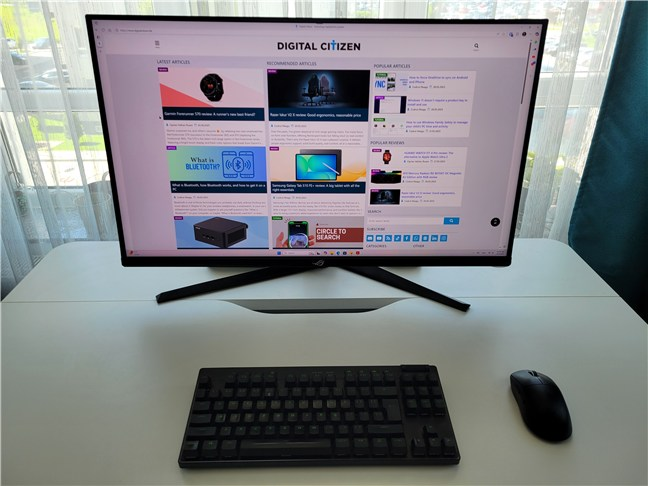

Using the graphics card in daily tasks
Once I began playing games, it showed what it was capable of. At 1080p resolution, performance was strong, and I didn’t have to make compromises to get smooth framerates. In Warhammer 40,000: Space Marine 2, a demanding game, I pushed settings to Ultra, then enabled FSR 4 in Quality mode. The result was excellent performance (I got over 100 FPS on average) and high image quality even during more demanding scenes. FSR 4 helped a lot here, upscaling without significantly decreasing image quality.
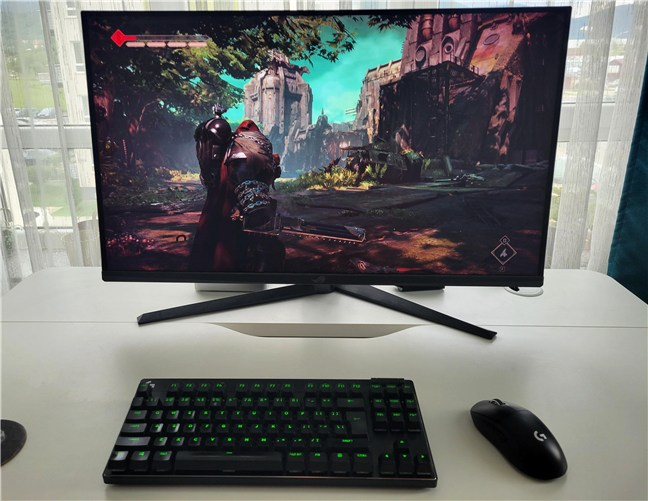

Playing Warhammer 40,000: Space Marine 2 with the AMD Radeon RX 9060 XT
In my experience, 1440p gaming on the ASRock AMD Radeon RX 9060 XT Challenger is quite good. That is… if you don’t expect maxed-out visual effects and graphics quality. In Star Wars Outlaws, for example, I played at 1440p with the High preset enabled and AMD FSR turned on (using the Quality preset), and the game looked great while the framerate was pretty high (in the mid-70s). Triple-A games such as this one won’t run on Ultra quality at decent framerates unless you make some compromises like enabling FSR upscaling. Still, with a couple of tweaks here and there, you can get a smooth gameplay experience in 1440p too.
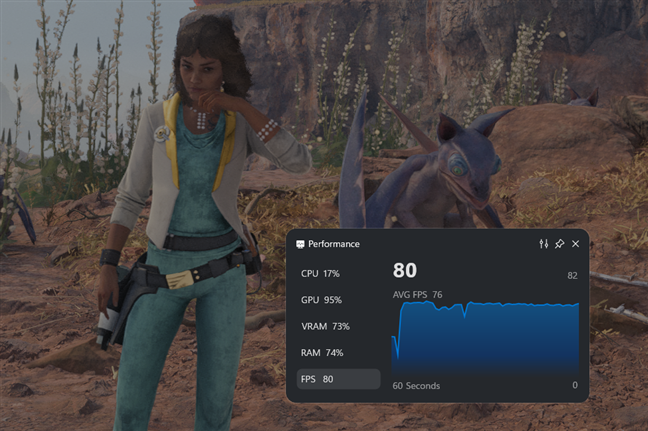

I got between 70 and 80 FPS in Star Wars Outlaws at 1440p
For me, the ASRock AMD Radeon RX 9060 XT Challenger felt fast and reliable, with stable performance and quiet operation both in everyday tasks and gaming at 1080p and 1440p resolutions.
Performance in games and benchmarks
To test the ASRock AMD Radeon RX 9060 XT Challenger 16GB OC, I ran a couple of demanding titles at their highest settings, including ray tracing where supported. I compared it against the ASUS PRIME GeForce RTX 5070 Ti, the GIGABYTE Radeon RX 9070 XT GAMING OC 16G, the ASRock Radeon RX 9070 Steel Legend, and the AMD Radeon RX 7600.
I began with Cyberpunk 2077, an extremely demanding game that requires top-notch performance from every hardware component in the system, but especially from the graphics card. The ASRock Radeon RX 9060 XT Challenger 16GB OC offered roughly 67.8% higher performance than the AMD Radeon RX 7600 at 1080p resolution. When compared to the ASUS PRIME GeForce RTX 5070 Ti, it delivered 50.5% of the latter’s performance. In 1440p resolution, the Radeon RX 9060 XT reached 47.5% of the GeForce RTX 5070 Ti’s framerate and was 314.3% higher than the one I got with the Radeon RX 7600.


Benchmark results in Cyberpunk 2077
In The Callisto Protocol, the ASRock Radeon RX 9060 XT Challenger 16GB OC handled the 1080p resolution extremely well, matching the Radeon RX 9070 and trailing the Radeon RX 9070 XT by just 12%. However, once I switched to 1440p, the differences became evident. The Radeon RX 9060 XT was around 31% slower than the Radeon 9070 XT and 24% behind the GeForce RTX 5070 Ti. If you’re aiming for high refresh rates or ray tracing at 4K resolution, this card falls behind. Still, for 1080p or 1440p resolutions, with all the eye candy turned on, it keeps up surprisingly well. It’s definitely not a horror show. In performance, at least, ‘cause this game’s story’s another thing completely. 🙂
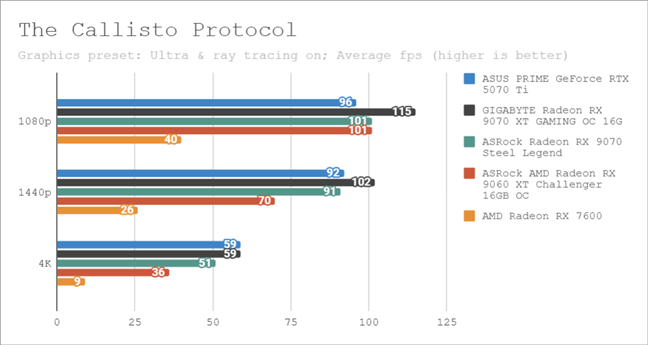

Benchmark results in The Callisto Protocol
In The Witcher 3: Wild Hunt Next-Gen Update, the ASRock Radeon RX 9060 XT Challenger 16GB OC was significantly more powerful than the Radeon RX 7600, especially at 1080p resolution. It delivered an 83% performance improvement over the Radeon RX 7600, which makes a big difference in a game this heavy, and with ray tracing turned on. At 1440p resolution, the Radeon RX 9060 XT proved to be 93% faster, doubling the frame rate compared to its predecessor. Still, it lags behind the Radeon RX 9070 XT by 45% at 1080p and over 48% at 1440p. And compared to the GeForce RTX 5070 Ti, the differences are above 50% at both resolutions. So, it’s quite clearly better than AMD’s previous-gen entry-level option, the Radeon RX 7600, but it’s also not quite built for high-end ray-traced action.
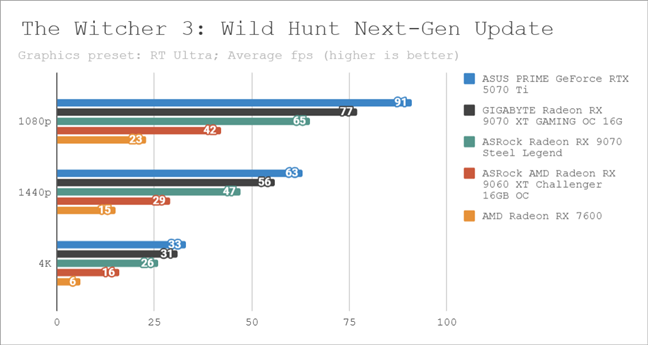

Benchmark results in The Witcher 3: Wild Hunt Next-Gen Update
Next came Total War: WARHAMMER III. Here, the ASRock Radeon RX 9060 XT Challenger 16GB OC was great at 1080p resolution, where it performed 50% better than the Radeon RX 7600. In 1440p resolution, while the Radeon RX 9060 XT still outpaced the Radeon RX 7600 by 55%, it lagged behind the Radeon 9070 XT by 48% and trailed the GeForce RTX 5070 Ti by 43%. Overall, the Radeon RX 9060 XT delivers excellent framerates in this game, especially at 1080p, making it a good choice for those who have high refresh rate monitors.
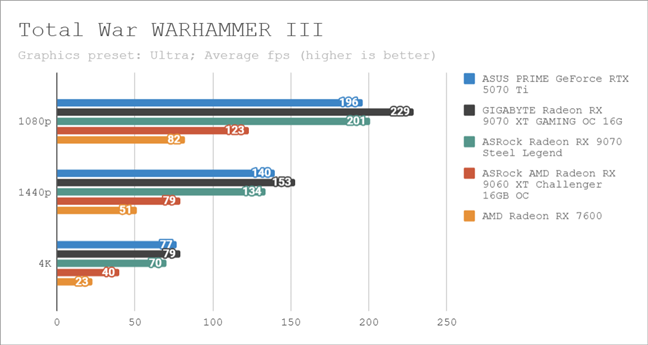

Benchmark results in Total War WARHAMMER III
In Assassin’s Creed Mirage, an older yet still demanding title, the ASRock Radeon RX 9060 XT Challenger 16GB OC offered excellent performance in 1080p, managing frame rates just 14% lower than the Radeon RX 9070 and 35% behind the Radeon RX 9070 XT. That’s still very good for smooth gameplay at high visual quality. At 1440p, the Radeon RX 9060 XT was around 41% slower than the Radeon RX 9070 XT and 31% behind the Radeon RX 9070. Even so, it stayed well above 90 fps, which means the game continued to feel smooth and responsive. So, while it doesn’t compete with the higher-end cards, it’s a reliable option for both 1080p and 1440p resolutions.
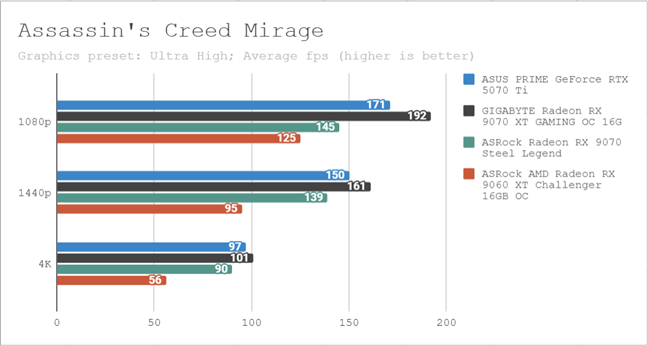

Benchmark results in Assassin’s Creed Mirage
In Resident Evil Village, the ASRock Radeon RX 9060 XT Challenger 16GB OC delivered great frame rates at 1080p, where it was 63% faster than the Radeon RX 7600. It stayed about 40% behind the Radeon RX 9070 and 47% behind the Radeon RX 9070 XT, which shows it’s clearly a step down from the high-end cards but still more than enough for smooth ray-traced gameplay at Full HD. At 1440p, the Radeon RX 9060 XT held on well, sitting 56% ahead of the Radeon RX 7600 and around 41% behind the Radeon 9070 XT. In conclusion, if you’re playing at 1080p or 1440p, this GPU handles Resident Evil Village comfortably, even at high quality settings.
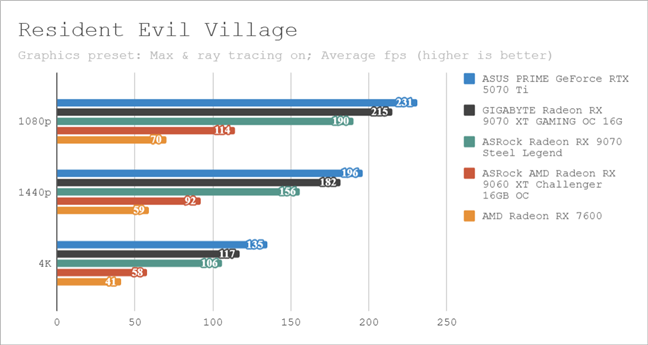

Benchmark results in Resident Evil Village
In F1 22, the ASRock Radeon RX 9060 XT Challenger 16GB OC delivered strong results at 1080p, beating the Radeon RX 7600 by nearly 49%. It was around 29% slower than the Radeon RX 9070 and trailed the Radeon RX 9070 XT by 48%. Even so, the game ran very smoothly with ray tracing enabled in Full HD. At 1440p, it remained competitive, still keeping a 55% lead over the Radeon RX 7600, though it fell behind the Radeon RX 9070 by 38%.. It’s clear that this GPU offers a major step up from older entry-level cards and offers enough 1440p performance for racing fans who don’t need to max out all the visual effects but still want a stable experience.
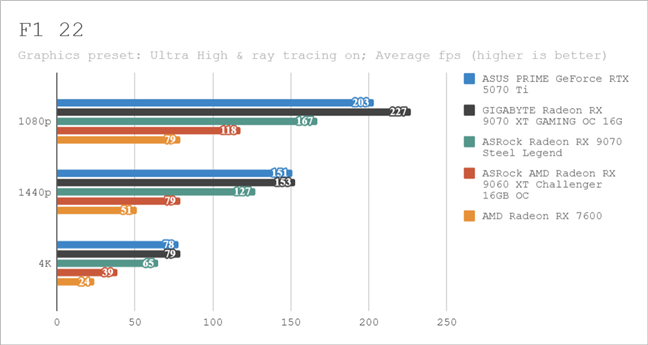

Benchmark results in F1 22
In Starfield, the ASRock Radeon RX 9060 XT Challenger 16GB OC delivered good framerates in 1080p, where it was 78% faster than the Radeon RX 7600. Even though it couldn’t quite catch the more powerful cards, it came within 22% of the Radeon RX 9070 and stayed 38% behind the Radeon RX 9070 XT. At 1440p, the differences became slightly more noticeable: the card was still 76% better than the Radeon RX 7600 but now 44% behind the Radeon 9070 XT. This game is known for demanding lots of system resources, and while the Radeon RX 9060 XT doesn’t crush it at high settings, it does make 1080p and 1440p playable with decent graphics quality. You’ll just need to accept that it’s not meant for Ultra quality settings at high resolutions unless you tweak a few things.
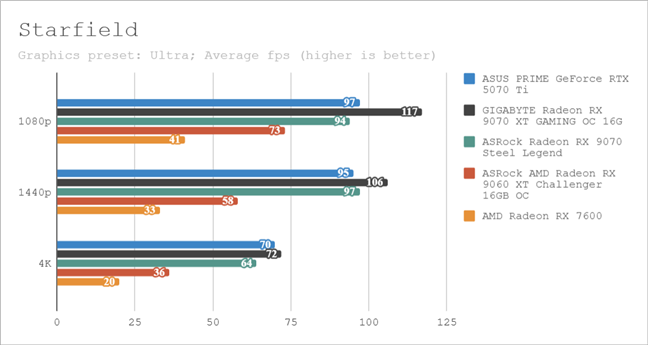

Benchmark results in Starfield
In 3DMark, the ASRock Radeon RX 9060 XT Challenger 16GB OC managed to receive some highly interesting scores, far ahead of the Radeon RX 7600 in all three tests I ran. In Time Spy Extreme, it scored 40% higher than the RadeonRX 7600, while in Speed Way (which is more ray-tracing focused), it got ahead by 47%. Port Royal, the test designed especially for evaluating ray tracing performance, showed the biggest jump, with a score that was nearly 497% higher than Radeon RX 7600’s. Of course, compared to the top-tier cards, the Radeon RX 9060 XT was still trailing.


Benchmark results in 3DMark
The ASRock Radeon RX 9060 XT Challenger 16GB OC kept cool even when stressed, hitting a peak temperature of 65°C (or 149°F). That’s lower than the Radeon RX 7600 and slightly cooler than the GIGABYTE Radeon RX 9070 XT. While it didn’t run at such a low temperature as the ASRock Radeon RX 9070 Steel Legend, it still stayed well within safe limits. Compared to the GeForce RTX 5070 Ti, which hit 73°C, the Radeon RX 9060 XT ran 8°C cooler. All in all, it looks like ASRock’s cooler design is doing its job, keeping the card quiet and thermally efficient, even if it doesn’t come with oversized heatsinks or a triple-fan design.
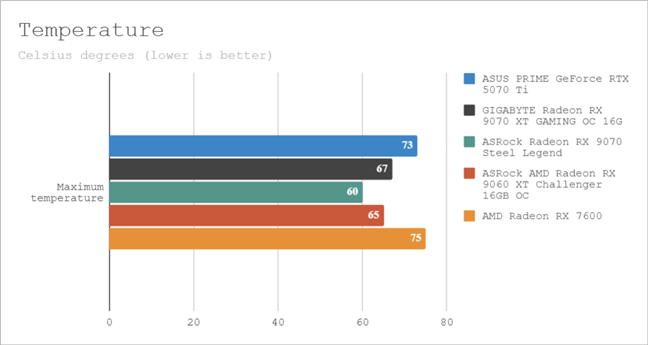

Maximum temperatures recorded
The ASRock Radeon RX 9060 XT Challenger 16GB OC was extremely efficient when it came to power usage. It peaked at 170 watts, which is just 4% higher than the Radeon RX 7600 and far lower than the higher-end cards. Compared to the ASRock Radeon RX 9070, it used 31% less power, and it drew almost half as much as the GIGABYTE Radeon RX 9070 XT, which got to a maximum of 330 watts. If you’re building a system with a smaller power supply or just want to keep your energy bill low, the Radeon RX 9060 XT gives you decent performance for quite a low power consumption.
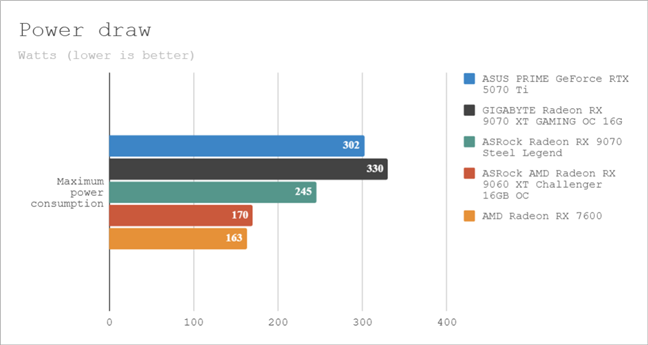

Peak power draw
Taking all the benchmark results into account, the ASRock AMD Radeon RX 9060 XT Challenger 16GB OC shapes up as a great fit for 1080p gaming and even works well at 1440p. No, it doesn’t match the performance of the higher-end models, but it’s not trying to. What it aims to do is offer solid performance at a fair price for the resolutions most people actually use. And I think it delivers exactly that; there’s no question about it.
What’s your opinion about the ASRock AMD Radeon RX 9060 XT Challenger 16GB OC?
In the end, this graphics card is unexpectedly powerful for its class. It also runs cool, doesn’t use too much power, and handles ray tracing better than you might expect at this price level. Sure, it’s not as fast as the high-end cards, but it also doesn’t cost as much or need a big power supply. So, what do you think? Is this the kind of GPU you’d use in your next build? Let me know in the comments.
Source link








